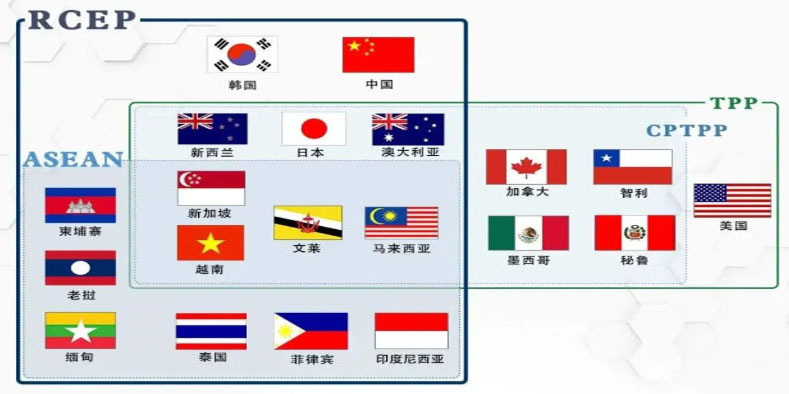
The Regional Comprehensive Economic Partnership (RCEP) entered into force on January 1 2022 – signifying the commencement of the largest free trade agreement in global economic history. At the centre of the partnership lies China, and a number of core members of ASEAN –
What is less clear, however, is the path forward out of the various challenges and quagmires confronting bilateral relations. Resolving these obstacles would prove to be immensely conducive towards securing mutually beneficial gains for China and ASEAN states alike – so such critiques should be viewed less as inherent criticisms and more as constructive amendments that China and ASEAN states could undertake.
The first concerns the fact that Chinese economic initiatives and aid in the region – whilst often generous and magnanimously offered – remains insufficiently embedded within the local economic ecosystem. To be fair, the injections offered by the Belt and Road Initiative deliver most certainly in increasing the aggregate output and investment amongst economies struggling with both the stringency of the terms and conditions of Western economic institutions and vicious cycles of deficient productivity.
Yet such generous investment does not adequately translate to the cultivation of homegrown talents and empowerment of a local technocratic class, which would be pivotal in ensuring the long-term sustainability of collaborative initiatives. As the Indonesian government’s response and counter-offers to Chinese investment over recent years indicated, Southeast Asian states have found themselves on the receiving end of significant
A more egalitarian relationship would behove both sides to engage in productive reforms: for Chinese firms, that looks like genuine skills transfer and capacity-building initiatives that, if anything, would yield longer-term political goodwill. For ASEAN governments, clearer communication of the desire to cultivate an independent, skilled workforce is pivotal. Countries engaged in benign competition would feed off one another in advancing innovation, as Philippe Aghion, Céline Antonin, and Simon Bunel note in their account of creative destruction.
Secondly, China would benefit from applying more scrutiny and due diligence to the loans it issues to national governments. Antagonistic narratives often accuse Beijing as engaged in “predatory debt trap diplomacy
If anything, China has the opposite problem – in withholding from imposing ideologically driven or economically stringent terms for their loans, China occasionally draws the short end of the economic stick by investing in inefficient and unrealisable white elephants. To offset such risks, seasoned bureaucrats have sought to raise interest rates to levels more comparable to commercial market rates – roughly 4%, whilst offering recipients tighter repayment schedules (less than 10 years).
Yet these stipulations do not address the root of the issue – that local vested interests and conniving politicians in ASEAN states may take advantage of China’s generosity, in squandering the loans through siphoning and crafty maneuvering. To counteract this systemic risk, therefore, it beh
Additionally, as it has already been doing domestically, China would benefit from making explicit the environmental, sustainability-centric, and social impact-oriented metrics of evaluation for developmental projects – only then, would this send a clear and unambiguous signal to ASEAN governments: no country is too big to fail, when it comes to paying off its debt; more important, debt and aid are neither unconditional nor a basis for self-enrichment. A particular benchmark by which this could play out concerns the regions to which Chinese aid flows – as noted by a recent AidData report, 62% of China’s financial assistance went to only 25 provinces out of the many Central and South Asian countries in which it invests. More diffused radiation and fairer distribution of the investment and loans, in line with the country’s vision for common prosperity, would most certainly be welcome.
This t
Some numbers would be useful here. The 2021 ISEAS-Yusof Ishak Institute in Singapore’s annual survey of regional opinion in Southeast Asia found that if the surveyed respondents were hypothetically forced to choose, 61.5% of the respondents would rather align with the United States, as compared with 38.5% for China; the latter was a substantial decline from the 46.4% in the year before. Now one may reasonably argue that this false dichotomy is perhaps unreflective – yet the same report also found that whilst 76.3% of respondents described China as the most influential economic power in the region (7.4% for the U
I do not believe, for one, that such perception problems are immutable. Nor do I believe that China’s soft power deficit in the region is entirely a product of its own making – after all, there exist plenty of interests for competing powers to portray Chinese involvement in the region through excessively negative and detracting lenses. Yet it is unmistakably apparent that China needs to work on winning the hearts and minds of citizens in ASEAN – not only for the sake of the diaspora in these countries, who have found themselves embroiled in Sinophobic discourses in recent years; but also in order for investments to truly flourish in the long run.
The solutions rest with a delicate and strategic combination of engaging in open, philanthropic and constructive humanitarianism; upping standards of transparency and accountability when it comes to Chinese investments in the region, as well as, above all, pulling back on the bellicose rhetoric that have come to characterise Chinese diplomacy over recent years. ASEAN states could well be excellent partners to China – but the precondition for that is a bilateral relationship formulated on
